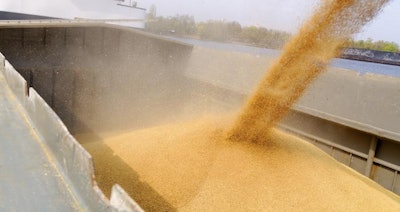
Globally, markets for commodities such as grains and oilseeds used in livestock feeds are described as “well balanced” in the latest Food Outlook report, the biannual report on global food markets from the United Nations’ Food and Agriculture Organization (FAO). This global balance does, however, mask less favorable situations for some individual countries and regions.
Corn
For coarse grains – a category including corn, barley and sorghum – FAO is expecting global production close to record levels. With ample supply, particularly from Southern Hemisphere countries, competition between exporting nations is likely to intensify.
The organization’s latest forecast for world coarse grains production in 2017-18 is 1,348 million metric tons (mmt), almost unchanged from its estimate for the previous year. While global barley and sorghum harvests are expected to contract, corn production in South America and southern Africa looks likely to recover from last year.
Compared with FAO’s estimate of almost 752 mmt in 2016-17, the global use of coarse grains in animal feed for 2017-18 is predicted up 1.5 percent at just over 763 mmt.
Wheat
Large stocks of wheat lead FAO to forecast plentiful supplies of wheat available this year despite global production expected to fall short of last season’s record. FAO describes the prospects for international prices during the first months of the season as “subdued.”
Global wheat production in 2017 is expected to be 743 mmt, according to the FAO forecast. This is 2.2 percent less than in 2016, the result of lower output from North America, the Russian Federation and Australia partly ameliorated by a recovery in harvest in the European Union and North Africa.
Global use of wheat for feed is forecast to be almost 134 mmt in 2017-18, which is 1.7 percent less than FAO’s estimate for 2016-17.
Oilseeds
For 2016-17, oilseed product supplies are exceeding demand, and FAO expects the recent downward trend in oil prices to continue into 2017-18.
For the current season – October 2016 through September 2017 – FAO forecasts total oilcrop production at more than 581 mmt, which is 8.8 percent more than the year before. More favorable growing conditions in all major soybean-producing countries and a recovery in palm oil output are the basis for this predicted increase, which is balanced by the continued fall for rapeseed.
For oilseed meals and cakes, FAO is forecasting a 10.2 percent increase in global production for 2016-17 compared to the previous season at almost 152 mmt. Utilization of these products is expected to be 5.1 percent higher this year at just over 145 mmt, driven by a continued strengthening of demand from the livestock sector.
Rising cost of food imports
Based on the increased volume of food products being traded around the world and rising costs of shipping, total costs of global food imports could be more than US$1.3 trillion in 2017. That is more than 10 percent higher than last year.

















